Matador Network's Blog, page 185
March 22, 2024
How Outdoor Alliance Has Saved the Natural Places We Love For 10 Years, and How You Can Help

Regenerative tourism is all the buzz in 2024. The term goes beyond sustainable travel and aims to have a positive impact on the destination’s environment and community, leaving it better than how it was found. This also can mean advocating for a better planet before you ever head out the door. Outdoor Alliance, a 501(c)3 non-profit organization, is celebrating 10 years of doing just that across public lands in the United States.
The organization’s unique approach to conservation and advocacy emboldens everyday travelers and recreators to band together to leave a positive mark on their favorite places – and it’s working. The group’s coalition has collectively protected some 40 million acres of land over the past decade, much of which is accessible to the public for outdoor recreation. The coolest part is that anyone can get involved today and make their next trip into the outdoors that much more rewarding.
Celebrating a decade of effective advocacy“Everybody’s got a place that they love, everybody’s got a place that they care about,” says Outdoor Alliance founder and CEO Adam Cramer in a video produced by SolMtn Studios for the organization’s 10th anniversary. “[Outdoor Alliance is all about] getting kayakers, backcountry skiers, kayakers, mountain bikers, all leveraging their love of place to preserve and protect places at scale.”
Outdoor Alliance combines 10 national organizations across the US that advocate for the protection of public lands. If you’re an avid outdoor recreator, you may have heard of – or even contributed to – some of the organizations that make up the coalition, which include the Surfrider Foundation, International Mountain Bicycling Association (IMBA), American Alpine Club, and more.
The video above highlights a particular successful advocacy effort, the John D. Dingell Public Lands Package. WIth the support of its coalition and the general public who voiced support through the coalition, Outdoor Alliance lobbied DC to protect more than 14 million acres and permanently reauthorize a major water protection fund. The result is better trail access throughout the 13,420-acre Cerro Del Yuta Wilderness and 8,120-acre Rio San Antonio Wilderness of New Mexico.
How you can get involved
The John D. Dingell Public Lands Package protected more than 14 million acres including the Cerro Del Yuta Wilderness of New Mexico. Photo: Dylan R.N. Crabb/Shutterstock
Think of getting involved with the alliance and its coalition partners as a contribution to conservation and restorative travel – their work takes the coalition to Washington, DC, to advocate for conservation efforts and the end result is better public spaces for recreators, improved habitat for plant and wildlife and cleaner air for all to breathe. Their platform allows travelers to actively participate in projects that benefit the broader recreation environment.
Outdoor Alliance offers many ways you can help. The quickest is to visit its website and fill out its pre-generated forms to send letters to your local government representatives advocating for issues like natural climate solutions, equitable access, and protecting land and water. Financial donations are accepted, and all coalition members routinely host their own in-person volunteer opportunities and letter-writing campaigns through their websites.
You can also partake in conservation and regenerative travel efforts outside of the alliance itself. This can involve supporting businesses with sustainable practices, cultural immersion experiences or even volunteering for conservation efforts. The core idea is that tourism should be a two-way street, enriching both the visitors and the places they explore. Organizations like Outdoor Alliance make it easy to get involved – all it takes is a few clicks and a desire to do the right thing.
“We’re able to turn that power into on-the-ground results,” Cramer says in the video. 
This 76-Mile Route in Nebraska Just Became North America’s First ‘quiet Trail’

Everyone understands why it’s important to reserve undeveloped areas — but even deep into the wilderness, there’s still one human-made thing that can be hard to avoid: noise.
But now, if you head to Nebraska, you can paddle, float, or hike near one of only two trails in the world designated as a “Quiet Trail” by Quiet Parks International.
The designation of Nebraska’s Niobrara National Scenic River as the first Quiet Trail in North America was announced in late 2023, making 2024 the ideal time to explore the trail’s 76 miles. The trail follows a section of the Niobrara Scenic River through the Great Plains, running from Valentine, NE, to just north of Newport, NE.

Photo: marekuliasz/Shutterstock
The river trail was selected as the second Quiet Trail in the world through a process that included quantitative audio testing and subjective takeaways from the Quiet Parks International selection team. “Beyond collecting standard acoustic data, each team member must agree, unanimously and unhesitatingly, that natural quite prevailed throughout the testing period,” said Quiet Parks International co-founder Gordon Hempton. “The Niobrara River’s splendid geologic landscape, unusual atmospheric conditions, and outstanding wildlife all contributed towards a positive outcome.”
The world’s first Quiet Trail is the Cuifeng Lake Circular Trail in Taiwan’s Taipingshan National Forest, which received the designation in 2022 and wraps around Taiwan’s largest lake.
The benefits of silence
Photo: Song_about_summer/Shutterstock
Silence and the sounds of nature offer a powerful double dose of benefits for our well-being. Silence itself can be a balm for our overloaded brains. In the quiet, we can experience a mental pause, lowering adrenaline and reducing stress. It’s also been shown to temporarily boost your creativity and make it easier to focus, which can help if you’re facing significant decisions or life choices that demand your undivided attention.
On a more superficial level, a reprieve from human sounds also allows you to better hear the sounds of nature. Studies have shown that listening to birdsongs, flowing water, and rustling leaves can do everything from lower your blood pressure to improve your mood to decrease your risk of cardiovascular disease. For most people, natural sounds trigger a relaxation response, countering the negative effects of constant noise pollution like highway noise, machines, and conversations.
“Quiet is rare globally, as 97% of the U.S. population faces noise pollution from sources like aviation and highways,” said Susan Cook, superintendent of the scenic river, in the release.
Other Quiet Places
Photo: Szilard Toth/Shutterstock
While the Niobrara National Scenic River is the first Quiet Trail in North America, it’s not the only location with a designation of some kind from Quiet Parks International. The gorgeous Glacier National Park in Montana was designated as a “Wilderness Quiet Park” in 2022, as was the Boundary Waters Canoe Area Wilderness in Minnesota in March of 2023. Like the new Nebraska site, the Boundary Waters Canoe Area Wilderness is primarily a paddling route, though it does have 12 miles of hiking trails and roughly 2,000 individual campsites.
Outside the US, the private island retreat of Cayo Loco in the Bahamas is designated as a “Quiet Place” — a designation for lodging and hotels that meet the organization’s criteria. In South America, Ecuador’s Kapawi Ecolodge — an Indigenous tourism cooperative in the Amazon — is also a Quiet Place, while the Zabalo River in Ecuador is also a Wilderness Quiet Park (the world’s first, no less).
While only a few places have an official awarded status, more than 150 locations around the world have been nominated and will eventually be evaluated for consideration. You can even nominate your favorite place via the Quiet Parks International website.
How to experience the Niobrara National Scenic River
View this post on Instagram
A post shared by Niobrara National Scenic River (@niobrararivernps)
Canoeing, kayaking, and tubing are some of the most popular activities on the Niobrara. Options range from leisurely float trips through outfitters based in Valentine, Nebraska, or more adventurous paddle or canoe trips, tailored to your skill level and desired pace.
Hiking is also an option, with the long-distance Cowboy Trail starting very close to the visitors center. The one-mile Fort Falls hike is also popular year-round, and nearby wildlife refuges include the Valentine Area National Wildlife Refuge and the Fort Niobrara National Wildlife Refuge. The Valentine refuge is more than 71,000 acres and is huge with birders as it’s one of a few places to see the weird and wonderful prairie chicken; and Fort Niobrara National Wildlife Refuge is home to bison and elk, with driving and hiking trails. 
Chicago’s Soaring New Attraction Takes You Flying Over the Windy City

Amid the hustle and bustle of Chicago’s streets lies a new attraction offering an escape from the city’s frenetic energy. Located at Navy Pier, FlyOver Chicago is a recently unveiled adventure that invites you to embark on a journey through the heart of the Windy City — without ever leaving your seat. The immersive attraction unfolds in three stages, each activating the senses and bringing guests closer and closer to Chicago.

Photo: Jeanie Fang
The FlyOver journey begins when you step inside a dimly lit room filled with digital screens showcasing a glimpse into the daily lives of Chicagoans. Here, scenes unfold with cinematic flair, from a mother strolling with her child to the rhythmic dance of water waves and the sizzle of freshly made tacos. (If you’re understandably keen to try those tacos after the experience, you’ll find them at Rubi’s Tacos in the Pilsen neighborhood.)
The journey continues as you walk upstairs to the pre-show chamber. Here, a disc-shaped globe takes center stage among 360-degree screen projections, offering a glimpse into Chicago’s soul. Guests are treated to a symphony of storytelling from native Chicagoans and powerful music from the Soul Children’s Choir. Even if you don’t live locally, the pre-show’s portrayal of Chicago’s spirit, culture, and community will leave you feeling a sense of pride and admiration for the city.

Photo: Jeanie Fang
The pinnacle of the FlyOver experience awaits in the final phase when you’re seated in rollercoaster-style chairs, with staff close by to ensure that everyone is securely buckled in for the exhilarating voyage ahead. As the seats ascend and the screens come to life with panoramic aerial footage of Chicago captured via drone, you’re swept away on a thrilling 3D-like adventure, soaring above iconic landmarks and hidden treasures scattered throughout the city.
As the immersive spectacle unfolds, you’re treated to awe-inspiring sights, from the green Chicago River during St. Patrick’s Day celebrations to the electrifying performances of the city’s renowned air show and choir. But it’s the intimate glimpses of everyday life, viewed from a bird’s-eye perspective, that truly resonate. Witnessing a street sideshow take place while ballet dancers are practicing a few stories above, you’ll gain a newfound appreciation for the bustling rhythm of Chicago’s streets.
Each twist and turn of the journey evokes a sense of exhilaration akin to a rollercoaster ride. While the seats may not move dramatically, the masterful synchronization of visuals and effects creates the illusion of dynamic motion, heightening the sense of realism. Adding to the sensory experience are subtle scents wafting through the air, transporting guests to different scenes, along with refreshing splashes of water that further blur the line between reality and illusion. It’s these meticulously crafted details that elevate the experience, making it feel remarkably lifelike and immersive.

Photo: Jeanie Fang
FlyOver Chicago isn’t just an attraction; it’s a celebration of everything that makes Chicago unique. Whether you’re a lifelong resident or a first-time visitor, the experience promises to leave a lasting impression, offering fresh insights and newfound appreciation for the city’s charm and allure.
I had the privilege of engaging with some of the luminaries behind the scenes during my visit. Among them was Sherman ‘Dilla’ Thomas, a distinguished local Chicago historian, who revealed how FlyOver sought to illuminate Chicago through the lens of its inhabitants, leading him to guide FlyOver to uncover hidden gems and local hangouts. I also had the pleasure of speaking with Maudlyne Ihejirika, the talented narrator of the pre-show. With eloquence and passion, she described FlyOver as a “love letter to Chicago,” capturing the essence of the city’s soul and heritage.
Delving deeper into the intricacies of FlyOver’s production, I spoke with David Mossop, FlyOver’s Associate Creative Director and Film Producer. Mossop illuminated the extraordinary precision required to orchestrate the drone flights, ensuring they soared in at precisely the right moments and locations. This behind-the-scenes insight amplifies the appreciation for the ride, underscoring the immense effort and dedication invested in crafting such a breathtaking spectacle.

Photo: Jeanie Fang
To make the most of your FlyOver experience, consider booking a stay at the Sable Hotel on Navy Pier, a mere stroll away from the attraction. After indulging in the spectacle, venture out to explore the featured landmarks showcased in FlyOver, such as the iconic Manny’s Deli, renowned for its generations-old tradition of serving up generously portioned pastrami sandwiches.
Tickets for FlyOver Chicago are affordably priced at $24.95 for adults and $14.95 for children 13 and under, making it the perfect addition to any Chicago itinerary. So, whether you’re seeking a moment of respite from the city’s hustle and bustle or you’re eager to discover Chicago from a new perspective, FlyOver Chicago invites you to embark on an unforgettable journey through the heart of the Windy City. 
This Wellness Resort Is a Relaxing Retreat Just Outside Los Angeles

The Four Seasons Hotel Westlake Village property in Southern California is a relaxing retreat in the foothills of the Santa Monica mountains. The hotel is less than 30 minutes West of the PCH and the sandy coastline and just an hour north of Los Angeles’ fast-paced urban sprawl.
The hotel encompasses an enormous, meticulously manicured 12 acres of land, including 230 guest rooms and 39 suites (making 269 accommodations total) spread across seven stories, and a myriad of outdoor spaces to explore on-site — including gardens with waterfalls, a greenhouse, walking paths, and the most recent addition to the property, an expensive outdoor pool area called “The Cove.”
The interior design is meant to emit a “Coastal California design meets old-Hollywood glam” aesthetic, with touches of semi-precious stones scattered throughout to add some sparkle. The overall color palette of the hotel draws from the nearby California coastal geography, bringing elegant beach vibes inside.
It’s such a large property that I had to ask for a map and directions to figure out how to get around. But once you have your bearings, it’s plenty easy to explore, and a great place to enjoy an urban retreat.
We hope you love the Four Seasons Hotel Westlake Village! Just so you know, Matador may collect a small commission from the links on this page if you decide to book a stay. Listed prices are accurate as of the time of publication.
Dining on-site at the Four Seasons Hotel Westlake Village
Traveling to California? Check out Matador’s California accommodations guides: These beautiful San Diego Airbnbs put you close to the beach and downtown The best 14 Airbnbs near Yosemite National Park 11 magical Airbnbs near Redwoods and Sequoia National Parks 9 dreamy oceanfront Airbnbs up and down the California coast 10 soulful beach Airbnbs for the perfect SoCal yoga retreat 12 very zen Joshua Tree Airbnbs perfect for families and groups These Airbnb stays near Disneyland offer an easy group vacation These Airbnbs near Knott’s Berry Farm put you close to legendary coasters

Photo courtesy Four Seasons
There are a few on-site restaurant concepts and an extensive in-room dining menu for those who are more into “breakfast in bed.”
I liked to start my morning at Stir, the airy and bright on-site coffee spot — it became a daily routine for me while I visiting. It feels distinctly open-concept, a modern spot to grab a coffee or light meal and get some work done. The coffeeshop also makes for a great place to people watch over a housemade pastry and pressed juice.
For dinner, make a reservation at the property’s California Brasserie outpost, Coin & Candor, which is inherently inspired by the true “California dream” of “making it in a challenging industry through hard work, a bit of luck, and determination to never give up.
The restaurant takes its name by way of a man named David Murdock’s life story. In 1943, Murdock was a homeless veteran with just a nickel and a penny in his pocket — but when a good samaritan loaned him $1,200 to purchase a closing coffee shop, his entrepreneurial spirit was ignited. He quickly became a successful business owner who grew to own many situational companies (today, he’s Chairman and CEO of Dole Food Company.) Mr. Murdock has a direct connection to the property as the founding and driving principal of the Center for Health & Wellbeing, as he’s also invested in finding cures for chronic illness and investing in life expectancy research.
In addition to its fascinating backstory, Coin & Candor serves up great California-esque dishes, taking inspiration from Chef Jesus Medina’s experience working in kitchens worldwide. Diners will enjoy fresh ingredients sourced from local farms, the on-site garden, and fresh fish caught from Malibu waters.
My pro tip is to order anything pastry-related because Pastry Chef Patrick Fahy is known for his legendary baked goodies like the beloved warm red fife sourdough bread and even the delicious, gluten-free Pandebono. I appreciated that the dress code at Coin & Candor is “California casual” — come as you are, whether dressed up to the nines for a hot date night or sporting comfortable leggings and athletic wear.
Those craving sushi can stop into ONYX Restaurant, where diners can dive into modern Japanese and sushi dishes in a sultry, dimly lit atmosphere that feels intimate and upscale. For a relaxing poolside snack or meal during the day, The Cove Restaurant & Bar serves seasonal Baja and Mediterranean dishes and fresh cocktails.
Finally, those who seek a secluded, intimate spot to grab a drink to kick off the evening or a nightcap on the weekend over a special signature experience at Prosperous Penny, the on-site speakeasy space that serves artisan cocktails and small bites in a social but exclusive-feeling atmosphere.
The Center for Health & Wellbeing
Photo courtesy Four Seasons
The wellness scene at this hotel is practically unparalleled. The Center for Health & Wellbeing team uses an all-encompassing approach to wellness based on four pillars of health — Nutrition, Life Balance, Fitness, and Spa — to create a balanced experience for visitors.
With this holistic attitude, “wellness” is not just about spa-going or achieving physical fitness (although the extensive fitness offerings like personal training sessions, guided hikes, and spa treatments including facials and massages might be enough of a temptation to visit).
Guests can go beyond the norms of traditional health regimes and sign up for nutrition experiences like a “Metabolism Assessment,” work on strategizing their life balances with relationship and family therapy, ease their minds with guided meditations and sound bath healing classes, and learn techniques for stress reduction. Even better — any guest can spend time inside the spa during their visit — it’s not exclusive to those booked in for a treatment.
I was visiting to experience an individual “wellness retreat,” in which The Center of Health & Wellbeing team gave me a customized schedule. There are three categories for wellness retreats: “Sustainable Weight Management,” “Optimum Performance,” and “Spa and Beauty.”
Included in my “Spa & Beauty” package, I enjoyed two nights of accommodations, three healthy “Feel Good Meals” per day, access to the daily rotating health and fitness classes, and one “wellbeing elective” per day. Since mine was spa and beauty-focused, I was offered two spa treatments — but if you’re there for “optimum performance,” you will get different options, like a Target Heart Rate Assessment.
My facial and massage treatments were divine — and I had never had a facial before, so I was a bit nervous. But the esthetician was an expert at her job and made me feel relaxed. After the treatment, I felt and looked like I was glowing.
Those who want to visit for just the day can invest in a “Wellbeing Day Pass,” which includes access to daily group well-being classes and workshops on-site, access to the center’s offerings as well as a wellness lunch served poolside, and one wellness elective to choose from the fitness, mind-body, or nutrition offerings.
Outside the spa, fitness fans like me will be enthralled with the enormous 16,000-square-foot Fitness Center, which has dozens of cardio machines, weight training stations, and a dedicated yoga/pilates studio. Accredited trainers host regular classes, and any guest can sign up for rotating options each day, ranging from indoor cycling classes to pilates, among other cardio and balance experiences.
I took one of the yoga classes and a “functional fitness” class. The sense of community and camaraderie between the guests and the employees stood out to me at the entire property, and especially at the gym.
Let’s focus on the spa – because it’s fantasticThe spa itself is immaculate, encompassing 40,000 square feet and boasting 28 treatment rooms (all with private terraces), including four suites with a private patio and plunge pool.
A wooden Chinese footbridge connected the spa’s two treatment room wings over a water feature amid the orchid-accented lounge spaces (one for men, one for women, and one co-ed space). There were also whirlpool water features in the women’s and men’s locker rooms.
It was relaxing just to lay inside on one of the daybeds and admire the design elements like the onyx-accented ceilings and bamboo floors. Outside, the adults-only serenity pool adjacent to the spa was a great space to soak up sun and sunshine, and it connected directly to The Cove.
Guest rooms at the Four Seasons Hotel Westlake Village
Photo courtesy Four Seasons
I spent the weekend in a “Waterfall View” room with a large bathroom, a deep soaking tub, and lovely views of the landscaped property below. I liked the room’s relaxed color scheme — an array of shades of whites and blues and plenty of natural light. It felt soft and simple but elegant and sophisticated — not too over-the-top — and was meant to evoke feelings of being near the sea. Taking luxury to the next level, rooms were even equipped with those high-tech “Ember” coffee cups to keep your coffee warm for hours. And the bed was extremely comfortable.
Other on-site activities and amenitiesGuests can’t miss the dedicated arcade area downstairs adjacent to the fitness center, which has plenty of entertainment, including video games and traditional games to play no matter what age you are (literally or just in spirit).
There are three pools to check out. The indoor family pool is connected to the fitness center and can be a great spot to relax, rain or shine — and it’s kid-friendly. The Outdoor Tranquility Pool is available to guests 18 and older, feeling like a sunny oasis. It’s attached to the spa and serves light bites and drinks to your reclining pool chair.
Other organized off-site activities available to guests include golf, watersports, hiking, mountain biking, and horseback riding trails near the property. There’s also rock climbing in Malibu, Malibu wine-tasting experiences, and plenty of upscale shopping opportunities.

Photo courtesy Four Seasons
The Cove“The Cove Pool, Kitchen & Bar” area is a special spot on-site — and it’s not just any regular hotel pool complex — it feels like the ultimate oasis of relaxation. The Cove debuted in late 2023, taking up more than two acres of buzzy social space at the property.
The Cove’s design elements are meant to evoke the feeling of sitting by the seaside, with blue and white decorative color elements that mimic a scene of sitting on the beach. There’s even a vaulted white and aluminum steel canopy to offer shade, meant to mimic the movement an ocean wave would have.
There are three whirlpool spas, a large pool, lounge seating, and private daybeds for rent, an area with a hammock to lounge in, and a raised bocce ball court. There’s also a raised bar and dining space to either hang out and watch a sports game on the television or order food and drinks delivered right to your chair via a poolside server.
I enjoyed the light atmosphere at The Cove — it feels like a spot you’d want to hang out for hours upon hours on a summer day with family or friends. Their cocktail selection was refreshing, and the food items were like an elevated version of what you’d expect to be able to order poolside, with a Mediterranean twist.
On-site art galleryThe art gallery was another detail of the property I thought was neat and unique. During my visit, it showcased the work of MegZany, a street artist sharing bold and provocative pieces, and the work of ZanyStudios, which represents artists from across the globe, curating and creating a collection of contemporary art (which was available for purchase on-site).
Details that make the Four Seasons Hotel Westlake Village stand out
Photo courtesy Four Seasons
I’m always impressed with the level of service I experience at a Four Seasons brand hotel. I appreciate how team members treat guests in an attentive but relaxed way to make them feel like they are in a natural friendship. This property, in particular, feels like a haven you could hide away in and enjoy a relaxing retreat to recharge without losing the comforts of being in Southern California (like the consistently sunny, warm weather and proximity to many nearby attractions).
Those seeking an overhaul of their health and wellness regime and who could use guidance in setting new habits can benefit from a “wellness stay” on-site, whether for an individual visit or a guided wellness retreat.
I appreciate that you don’t have to go two hours into the countryside to feel like you’re escaping the stress of the city with this property. Based on my experience, I believe it’s a great destination to escape the hustle of Los Angeles life, hosting everything needed to relax and feel like you’re a world away from the chaos of every day while only being a few miles outside (and still accessible to) the excitement of the city. 
March 21, 2024
The 20 Airports Where You Can Skip the Security Line For Free by Reserving Ahead

The dreaded security lines at airports are the reason why travelers show up hours early before a flight. You never know long it’ll take to queue until it’s your turn to go through the humdrum of the security inspection. Of course, there are ways to make the process faster, namely becoming a member of the TSA Precheck program, or signing up for CLEAR Plus. Both services allow you to skip the security lines, but TSA Precheck requires you to apply and go though an interview with a TSA agent, and CLEAR asks $189 per year for the benefit.
If neither of those options work for you, there is now a third solution: RESERVE. RESERVE, a service offered by CLEAR, allows travelers to book a spot for the security inspection, thereby bypassing the lines entirely, but it does not cost a penny, and does not require any paperwork or subscription of any kind. All your have to do is visit the RESERVE webpage, select the airport you’re going to depart from, enter your flight information and the number of travelers in your party, and book the time that works best for you to go through security.
There is a 20-minute grace period in case you are late and you can book a spot for up to 10 people. How far in advance you need to book that spot, however, depends on the airport you’re departing from.
While CLEAR Plus is offered in 55-plus airports around the world, RESERVE is a service offered in 20 airports, including six airports in Canada, six airports in Europe, and eight airports in the US:
In Canada:
Toronto (YYZ)Vancouver (YVR)Montreal (YUL)Calgary (YYC)Edmonton (YEG) Halifax (YHZ)In Europe:
Amsterdam (AMS)Berlin (BER Runway)Frankfurt (FRA)Hannover (HAJ)London (LHR)Rome (QPass)In the US:
Denver (DEN)Los Angeles (LAX Fast Lane)Minneapolis (MSP)New York (JFK)Newark (EWR)Orlando (MCO)Phoenix (PHX)Seattle (SEA Spot Saver) More like thisAirports + FlyingNew Airport Tech Reduces Security Time By Half, But It's Only Universally Used in the UK
More like thisAirports + FlyingNew Airport Tech Reduces Security Time By Half, But It's Only Universally Used in the UK
La Dolce Vita in Luxury: Photos of Italy’s New Orient Express Train Showcase Opulent Travel
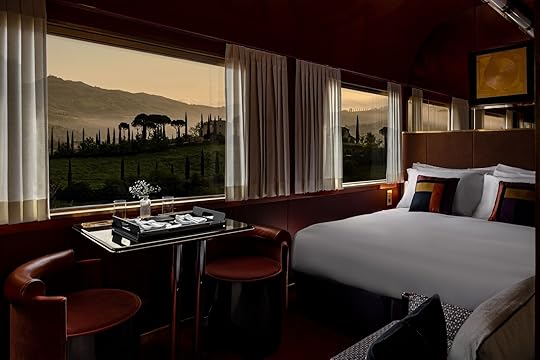
For more than a century, the name Orient Express has been synonymous with luxurious train travel. It’s taken on a fresh meaning in recent years as interest in train travel has spiked. New Orient Express routes are keeping the magic of that name alive, the latest being the La Dolce Vita Orient Express, with ticket sales starting in April after a presale period that started in December 2022. (Impressively, 400 cabins have been pre-booked since that time.)
It’s the first Orient Express experience to partner with the luxury Italian hospitality company Arsenale. As the name suggests, this is opulence done the Italian way for a made-in-Italy theme.
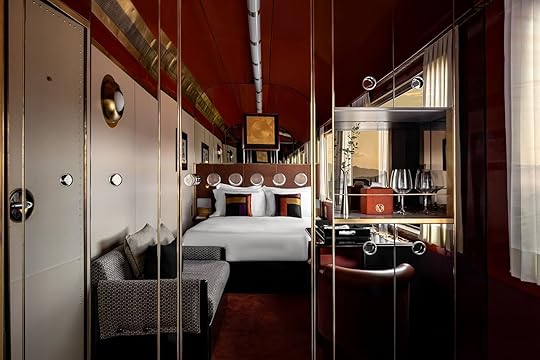
Photo: La Dolce Vita Orient Express
“The train pays tribute to the years of ‘La Dolce Vita,’ a fantastic period of history, to the artistic and cultural fervor of Italy in the 1960s,” a press release explains. That means channeling the “Italian way of life” along each journey with a restaurant, lounge, and bar. Guests can stay in one of 12 deluxe cabins, 18 suites, or the premium “La Dolce Vita” suite. Throughout it all, the art and design pulls from ‘60s and ‘70s.
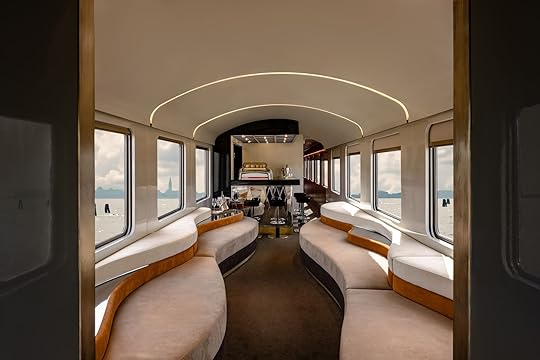
Photo: La Dolce Vita Orient Express
La Dolce Vita Orient Express will have nine journeys, the first starting in spring 2025:
Venice to PortofinoVenice to SienaMatera to PalenaA wine journey in MontalcinoA wine and truffle trip in the wine region of MonferratoMaratea to PalermoPalermo to RomeA train trip through SicilyA trip around Sicily and the Mediterranean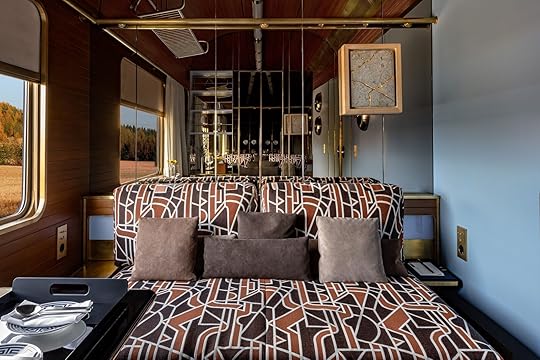
Photo: La Dolce Vita Orient Express
Regardless of the route, guests will be treated to service from international chefs and sommeliers who will bring Italian food and fine wine to the experience. Luxury isn’t just on the trains, either. The Rome Ostiense station, for example, has a La Dolce Vita lounge to enjoy before boarding.
“Today marks a concrete step towards the realization of a dream for many, but also the beginning of a new Italian frontier in the luxury market,” Arsenale Group CEO Paolo Barletta says in a press release. “We have created a new market segment: Rail cruises, and the response from pre-bookings has already signaled the success of this initiative. Italy can once again play a leading role, not only nationally but also internationally in the world of tourism, increasingly intercepting high-end tourism and creating a winning model. That’s why we have decided to invest in a unique product capable of creating the conditions to welcome millions of travelers in a new, entirely Italian form of slow, sustainable, and luxury tourism”
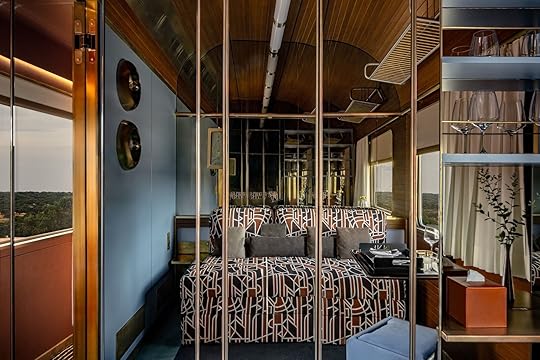
Photo: La Dolce Vita Orient Express
This level of luxury, of course, comes with a price. One-night itineraries start at €3,500 (about $3,800) per person for a deluxe cabin and €4,700 (about $5,100) per person for a suite. 
You’ll Soon Be Able to Pool United Miles for Your Next Group Trip
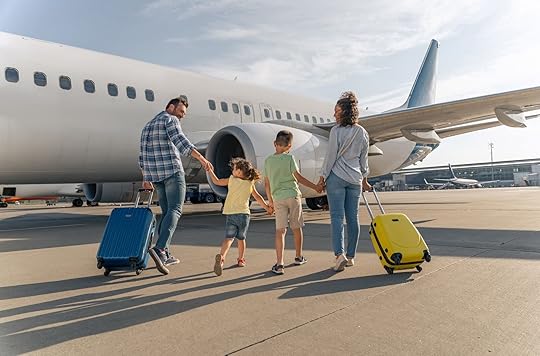
If you’re a MileagePlus member with airline miles to spare, United Airlines is making it easier to share your miles with family and friends.
Self-proclaimed “serial airline leaker” and “aviation watchdog” JonNYC posted on X yesterday that United will be introducing a mileage-pooling feature. MilagePlus Chief Operating Officer Luc Bondar confirmed the news via Travel and Leisure, noting that United is the first major US airline to incorporate the feature.
The concept of mileage pooling is simple. It gives travelers belonging to the same airline loyalty program the ability to create a collective account and redeem miles from that account as they see fit. United’s mileage-pooling feature will allow up to five MileagePlus members to join a shared account. All it takes is one traveler aged 18 or up to start a pool, invite up to four travel companions of any age to join, and leave it to the group to divvy up miles. Joining a pool will only impact your group’s ability to share and redeem miles, not individual members’ airline statuses.
Currently, United has a program that allows MileagePlus members to transfer miles to other travelers, but it comes at a cost: $7.50 for every 500 miles transferred, plus a $30 processing fee. That means that if you wanted to transfer 100,000 miles, the maximum amount you’re allowed to transfer in one go or in a calendar year, you’d have to pay a total of $1,530. The new mileage-pooling feature introduces a new way to share miles among a dedicated group of travelers at no cost.
Other US airlines, including Southwest and American, have similar mileage-transfer programs in place while JetBlue, Frontier, and Hawaiian already allow mileage pooling. United will become the first of the four biggest US airlines (a group that also includes Delta, American, and Southwest) to introduce mileage pooling, adding yet another reason why MileagePlus tops the list of the best frequent flyer programs and United earned Matador’s Best Airline Award last year.
But United’s not the first major global airline to implement a pooling program.
International airlines that allow mileage poolingAegean AirlinesAeromexicoAir CanadaAir FranceKLMAir IndiaANAAsiana AirlinesBritish AirwaysEtihad AirwaysEmiratesEgyptAirJapan AirlinesKorean AirLufthansaNorwegianQantasQatar AirwaysSingapore AirlinesTurkish AirlinesVirgin AtlanticVirgin AustraliaNote that every airline’s mileage-pooling program has different requirements, including airline status eligibility, member age, and size limits. Be sure to check the individual airline’s policy before booking your next group trip. 
Why You Should Always Buy the All-Inclusive Cruise Package
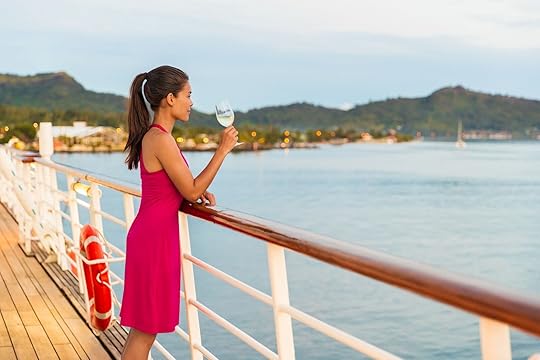
The great thing about cruising is that all your basic vacation needs, namely accommodation, food, and entertainment, are covered. The very annoying thing about cruising is that everything else is an upsell. With most cruise lines, espresso coffee, for example is not included; if you want a latte, you’ll have to pay extra. If you want to partake in one of the fun fitness classes listed on the daily schedule, you’ll have to pay around $20 a pop for that, too. And that’s just the start.
My first-ever cruise was an all-inclusive trip with the now-defunct American Queen Voyages, and it completely spoiled me for other sailings. When I boarded my second cruise, a not all-inclusive journey to Alaska, I had no idea of the sales pressure that awaited me. Just after embarkation, I went off to explore the ship and landed on the indoor pool deck, where large sales tables full of pamphlets and posters were laid out. From there, crew members praised the benefits of drinks packages, specialty dining restaurants, and unlimited thermal suite access, all of which where at a very special discounted price on embarkation day only, of course.
Drinks packages ranged from $8 per person per day for unlimited Coca-Cola, to $59.99 per person per day for unlimited soft drinks and specialty coffees, and 15 alcoholic drinks daily. Because I don’t drink either alcohol or soda, I did not fall for the sales pitch, but those who did added a substantial amount of money to their tab, from $56 to $420 per person for the entire seven-day voyage. The same goes for the unlimited thermal suite access, which allowed travelers to enjoy the large communal hot tub, saunas, steam rooms, and heated loungers any time they wish for just $150 instead of $300.
After deftly managing to not spend an extra penny on the pool deck, I went on to tour the spa where I was introduced to the onboard medical specialist — a man wearing a white lab coat but whom I’m pretty sure was not an actual doctor — who was keen to offer auricular pressure as preventive treatment for seasickness. He was adamant that I’d need it later in the trip, when the water was going to get rough, but there was no way I was going to pay a bundle to get seeds taped to my ears by some snake oil merchant.
Only a few hours into their vacation, attracted by looked like good deals, some passengers had likely added hundreds of dollars worth of perks to their tabs, possibly without realizing that gratuities, which amount to around $18 per person per day across cruise lines, were also going to be added to their onboard statement every single day.
Of course, while the crew works very hard at making people spend money, nobody forces you into purchasing a package or booking specialty dining. You can purchase a glass of wine with dinner, or a mid-morning cappuccino when the fancy strikes you. You can also book a one-day access to the thermal suite or dinner at the onboard steak house when you feel the need for something special, but that will add up, too.
After trying out both all-inclusive and not all-inclusive cruises, I’m now entirely sure that the add-ons are how cruise lines make a lot of their money. Like I have experienced, you can cruise for nearly two weeks across the Atlantic for less than $500 per person, but if you hit the specialty dining venues, buy a drinks package, want access to the spa, and book excursions (some of which are definitely not worth it), you can easily double, or even triple your spendings.
While you should absolutely indulge during your vacation, whether in the spa, at the bar, or by going on fun excursions on shore, having to watch your onboard statement rise every single day is not conducive to properly relaxing. An all-inclusive cruise vacation is the way to go.
One such vacation will soon be possible with cruise line HX, formerly known as Hurtigruten Expeditions. Starting in November 2024 HX will make all its sailings all-inclusive. That means that all of the following will be included in the price paid by passengers upon booking:
Daily expeditions and activities such as hikes, community visits, talks and moreFull board dining, including breakfast, lunch, and dinner with house wine and beerWine, beer, spirits, and cocktails available throughout the day and eveningAll-day coffee, tea, and soft drinksFree Wi-FiGratuitiesAccess to sauna, hot tubs, fitness roomProfessional photos from the onboard photographerExpedition gear and reusable water bottle which travelers can take homeOf course, the initial price of traveling with HX will likely be a little higher than before, but it’ll be worth the peace of mind for passengers who will be able to enjoy everything the cruise line, the ships, and the destinations have to offer without having to dig further into their pockets, or miss out entirely on what makes a great cruise vacation.
Which cruise lines are all-inclusive?While most cruise lines offers all-inclusive packages — including Holland America Line, Princess Cruises, and more — only few cruise lines are fully all-inclusive, and those that are tend to be on the luxury side of things. Those cruise lines include Atlas Ocean Voyages, Oceania, Viking, Uniworld, Regent Seven Seas, Azamara, Silversea, and more. Some of them go as far as including flights, airport transfers, and pre-cruise hotels in their offerings. That said, travelers don’t have to book high-end cruises to benefit from perks. Virgin Voyages, for example, does not call itself an all-inclusive cruise line, but its base fare encompasses more than most: access to all the dining venues on board, fitness classes, WiFi, gratuities, all the entertainment, and a soda and drinks package. 
New Mom? A Postnatal Retreat Might Make a Great Next Trip.

Giving birth, no matter how many times you’ve experienced it, is a marathon, not a sprint. It’s a physically demanding experience, often accompanied by physical injury, stitches, and sleep deprivation. While the weeks and months after welcoming a new baby into your home are often filled with lots of happiness, they’re also extremely taxing and extremely stressful, especially for new moms, who have to be caregivers immediately after going through the exhausting process of childbirth.
The American College of Obstetricians and Gynecologists makes it clear: “The weeks following birth are a critical period for a woman and her infant, setting the stage for long-term health and well-being.” Unfortunately, the United States falls short when it comes to supporting new mothers in this crucial postpartum period. In the US, the average hospital stay post-delivery is a mere 24-48 hours, meaning that many women leave the hospital or birth center while they still need significant care, and without much guidance for navigating the initial weeks of newborn care. This is part of the reason the US currently ranks 59th in the world for maternal mortality. The US also has no required paid maternity or paternity leave.
In stark contrast, many Asian cultures view postnatal care as a cornerstone of well-being for both mothers and new children. In South Korea, 80 percent of new mothers choose to take postnatal retreats, called sanhujori, despite the $2,000 to $5,000 price tag. These facilities offer new mothers a nurturing space to recover for about two weeks, with pampering treatments, bespoke parenting education, and a dedicated support staff.
Fortunately, this trend in prioritizing womens’ health after childbirth is beginning to take root in other parts of the world. Postnatal retreat centers are popping up across the US and internationally, offering a much-needed haven where mothers, parents, and babies can go to start the next chapter of their lives on a confident, healthy footing.
Postnatal retreats fill a skills and support gap missing for most parents
Photo: Anatta_Tan/Shutterstock
The rise of postnatal retreat centers can be attributed to the personal experiences and observations of passionate women who wanted to create change. Boram Nam, who co-founded her eponymous Boram Postnatal Retreat in New York City, battled postpartum depression after the birth of her second child, all while healing from a difficult C-section. “It took me two years to fully recover from it,” she explains. Her name, and that of the retreat center, fittingly translates to “something fruitful after hard work,” reflecting her desire to help other mothers avoid similar struggles.
Esther Park of Ahma & Co in Orange County, California, was also inspired by the postnatal practices in her native South Korea. And after witnessing friends and colleagues struggle in the aftermath of childbirth, she headed to an MBA program with the sole mission to launch a retreat. Similarly, nurse Jennifer Darwin founded San Francisco’s Village Postnatal Retreat Center after witnessing firsthand the struggles of new parents, and Julia Kim opened Sanu Postpartum Retreat in Washington, DC, after feeling helpless following the birth of her child despite months of research.
The common force behind all of these women is a deep desire to bridge the gap in support for mothers during such a critical time. Currently, in the US, only about 56 percent of mothers take any kind of parent education class, and even fewer do any kind of postnatal recovery. Less than 60 percent of new mothers have even a single postpartum follow-up or care visit, let alone any kind of extended recovery plan. Anywhere from 20 percent to 40 percent of women in research surveys reported that services like infant feeding classes or assistance with maternal recovery would have helped lower their stress in the weeks and months after giving birth.
It’s a gap that exists outside the US as well. To the north, Hana McConville of the Alma Care retreat in Toronto, Canada, leaned on her personal experiences to influence the structure of her postnatal recovery center. After the birth of each of her children, she practiced the Chinese tradition of zuo yue ze, or “sitting the month” – spending a month recovering and relaxing, working primarily on her own healing. She witnessed the positive impact of that practice, and saw the stark contrast compared to her friends in Canada who didn’t have time to “sit the month.”
In France, Get Your Mojo Back, Sex, Pleasure and Intimacy After Birth author Clio Wood founded the &Breathe center after dealing with birth trauma, postpartum depression, and breastfeeding issues after the birth of her daughter. “I found that there was very little support for new mums that didn’t revolve around the baby,” she says, and explains that she started the postnatal retreat to create the kind of space she couldn’t find. “Nothing like that existed, so I created a retreat to do just that.”
Who can attend a postnatal retreat?
Parents, moms, dads, and sometimes, even other children, are welcome to attend. Photo: NDAB Creativity/Shutterstock
One of the biggest questions surrounding postnatal retreats is who qualifies to attend. The answer is reassuringly broad: most retreats welcome any person who has given birth within a specific window, typically ranging from six to 12 weeks postpartum. Fathers are welcome and encouraged to attend, too. But there are some exceptions. For example, Clio’s &Breathe welcomes families of children up to preschool-age.
A common misconception is that these retreats are solely for first-time moms, but postnatal retreat centers are open to any mother or birthing person, regardless if it’s their first child or their fifth. There’s also flexibility on when parents attend prenatal retreats. Alma Care in Toronto welcomes both mothers and children directly from the hospital, and mothers who are several months into parenthood and may just need to fight burnout, catch their breath, and receive support with sleep training.
While some of these retreats may seem indulgent, they’re not just luxurious spa getaways or breaks from parenting duties. “Once you become a parent, you never get a break,” explains Nam of Boram Postnatal Retreat. “Our retreat is a chance for moms to receive support, slow down, bond with their new baby, and learn from experts so that they can feel more confident at the start of their journey as a parent.”
What happens during a postnatal retreat?
Photo: Kzenon/Shutterstock
So, what can you expect at a postnatal retreat? Many emphasize an around-the-clock care model, including a dedicated nursery staffed by professionals who can care for your newborn while you and your partner get much-needed rest. Pelvic floor health is also a priority, with many facilities offering physical therapy sessions to strengthen this crucial system, especially as it gets taxed during the birth process.
Support and educational classes from experts is another hallmark of most retreats, with attendees able to take workshops led by lactation consultants, meet with instructors teaching infant CPR and safety training, and connect with early childhood education specialists, doulas, nutritionists, nurse practitioners, and more. The idea of having so many different types of experts and lessons is to ensure attendees received a holistic education focused on both newborn care and personal recovery.

Most postnatal retreats offer chances for much-needed pampering and comfort. Photo: AbElena/Shutterstock
Comfort and pampering, of course, are also part of the equation – something that seems fair, given what a woman’s body goes through while pregnant and during birth. Guests can expect luxurious suites equipped with everything new parents need, nourishing meals, and spa treatments like massages and facials. But beyond these indulgences, postnatal retreats can foster a sense of community by offering parent workshops and lounges where attendees can connect with other families and build connections and communities they can lean on well after their departures. This can be especially helpful for new moms who don’t have many friends or family members with children.
Of course, these retreats aren’t just for mothers or birthing partners. Surveys have found that a quarter of new dads feel isolated and left out during the postnatal period, and that a large percentage of new dads also feel unprepared for their roles as parents (and as caregivers for mother), contributing to physical stress and potential relationship strains. Retreats offer workshops to relieve these issues, and much-needed chances for dads to bond with other dads.
Some retreats, like &Breathe, sponsor date nights for couples to reconnect, which are often the first time couples have been out alone since their baby arrived.
Postnatal support has short- and long-term benefits
Photo: bbernard/Shutterstock
Most supporters of postnatal retreats think that prioritizing postnatal care, especially through retreats, has benefits that last beyond the immediate postpartum period. At a minimum, they start normalizing a more realistic counterpoint to the societal narrative around motherhood.
“The ‘cult of motherhood’ places so much emphasis on selflessness and always giving to and providing for others,” says Wood of &Breathe. “Actually, as a mother [and birthing person], you deserve just as much care. But we often feel a lot of shame and guilt for needing and taking this.”
Investing in postnatal care, particularly addressing pelvic floor health, can have a profound impact on a mother’s long-term well-being. According to the National Institutes of Health, nearly a quarter of all women in the US develop pelvic floor issues after giving birth. These issues can range from urinary and fecal incontinence to back pain to organ prolapse.
“Absolutely everyone should have access to a women’s health physiotherapist in the postnatal period,” says Wood. But in the US, only a very small percentage of people who give birth have access to physical therapy, despite the fact that studies have shown it could save lives and speed up the recovery process – which benefits not just mothers, but everyone in the family. Postnatal retreats also provide crucial emotional support during a vulnerable time. Early intervention and strong support networks are proven to reduce the frequency of postpartum depression and help mothers begin to feel like themselves again.
“A lot can happen in the immediate postpartum, and we help people navigate what is normal,” explains Darwin of the Village Postnatal Retreat Center. “We educate parents on signs and symptoms that should be reported to their providers, and do the same for the babies through daily weigh-ins, assessing sleeping patterns, and feeding patterns, etc.”
Of course, the costs of a postnatal retreat can be a barrier for some. The Village starts at $890 a night with a three-night minimum, and Sanu is between $835 and $880 per night. In Canada, Alma Care is between $850 and $1,000 per night, and &Breathe stays start at £1250 (about $1,590) per adult for a six-day retreat. Most US insurance companies don’t cover the cost, but some postnatal retreats will provide you with an itemized bill you can submit to try to get some parts of the retreats reimbursed, such as physical therapy. Ideally, the knowledge and skills gained in a retreat will lead to fewer hospital readmissions and unnecessary doctor visits, reducing some future medical costs.
While the rise of postnatal retreats is a positive step for women, the reality is that this type of care is far from universal. But for now, the growth in their availability and the number of women and families who attend one will hopefully begin to change the way they’re viewed in society — not as an indulgence, but as an essential investment in the health and happiness of every growing family. 
Your Next Big Eurotrip Just Got Bigger, Thanks to These New Schengen Entries
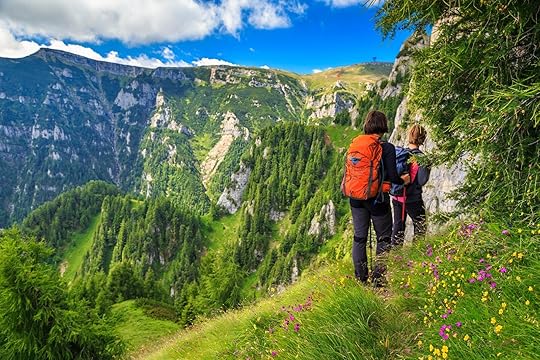
On March 31, 2024, Bulgaria and Romania are to join the Schengen — the largest area of free movement in the world. Although both Balkan countries have been members of the EU since 2007, the borders have been guarded by passport control, and citizens have been required to show documentation when traveling around Europe. Being added to the list of Schengen countries not only means that Bulgarians and Romanians can join the close to 450 million other EU citizens and travel with ease but vacationing in the two beautiful nations will be more straightforward for visitors.
The Schengen area is a zone in Europe comprised of 27 countries that have eliminated border controls between each other. This means you can travel freely between these countries without going through passport checks. Bulgaria and Romania will be in good company, they join the following countries:
AustriaBelgiumCroatiathe Czech RepublicDenmarkEstoniaFinlandFranceGermanyGreeceHungary Iceland ItalyLatviaLiechtensteinLithuaniaLuxembourgMaltathe NetherlandsNorwayPolandPortugalSlovakiaSloveniaSpainSwedenSwitzerlandAt the end of this month, Bulgaria and Romania will no longer have controls at sea and air borders. Land border controls will remain, and lifting these will be discussed later this year.
Last January, Croatia joined the Schengen and adopted the euro, lifting its air borders to Schengen countries on March the same year. Matador Network reached out to American expat Michelle Walters, who has lived in Zagreb, the capital of Croatia, for over a decade to enquire how these changes have impacted everyday life for Croatians.
“There’s been a huge influx in tourists coming to Croatia. Last summer the coastal regions were packed,” explains Walters. “This has made vacationing here much more expensive for everyone.”
Matador asked Walters whether she thought this was in part due to Croatia joining Schengen. She was unsure if there was a direct relationship. “People like something to blame for the rising cost of living, yes the change to the euro has been rough, but we’re seeing costs sky-rocket across the world. Croatia is not alone.”
Although there is concern over price hikes in Bulgaria and Romania, at this time, it’s speculation. Instead, many are focusing on what the countries have to offer tourists.
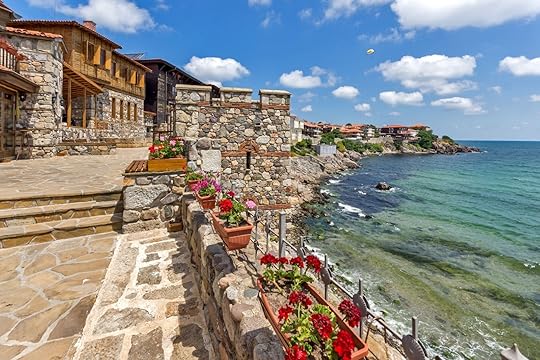
Photo: Ceri Breeze/Shutterstock
The Black Sea Coast, the Rila and Pirin Mountains, the busy nightlife of the metropolis Sofia, and the ancient streets of Plovdiv — one of the oldest cities in the world and Europe’s Capital of Culture in 2019 — are some of the highlights in Bulgaria. And let’s not forget the food culture. The country is an exciting place to visit for the traveling foodie.
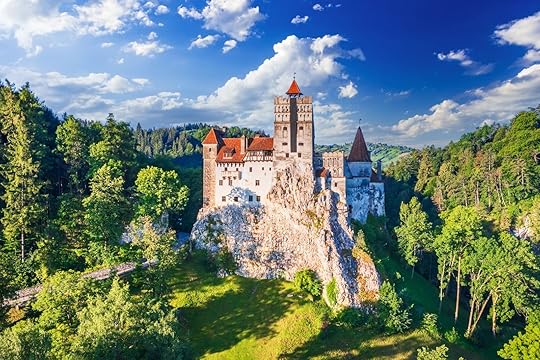
Photo: Gaspar Janos/Shutterstock
While scenic, Transylvania and Bran Castle are far from the only things you should see in Romania. You can hike or bike in the Carpathian Mountains, which cover a large part of the country. The scenery is stunning, and there are trails to suit all levels of ability. You can even go white-water rafting or spelunking. If you have an interest in wildlife, head to the Danube Delta and enjoy the water and birdlife by canoe or on a kayak. Or visit Bucharest, the culture-rich capital, and enjoy the nightlife, excellent restaurants, and art scene that runs down the cobblestone streets of the Old Town.
What is the difference between the EU and Schengen?The EU and Schengen are both about European integration, but in different ways. The EU is a broader political and economic union, with its own parliament and laws. Schengen, on the other hand, is a separate agreement focused on creating a zone without border controls.
Can a US citizen get a Schengen visa?If you are a US citizen traveling to the Schengen area for tourism, business, or visiting family or friends, and your trip is for less than 90 days within a 180-day period, then you generally do not need a visa. Just make sure your passport is valid for at least three months. You will need a visa if your trip exceeds the 90-day window. 
Matador Network's Blog
- Matador Network's profile
- 6 followers



